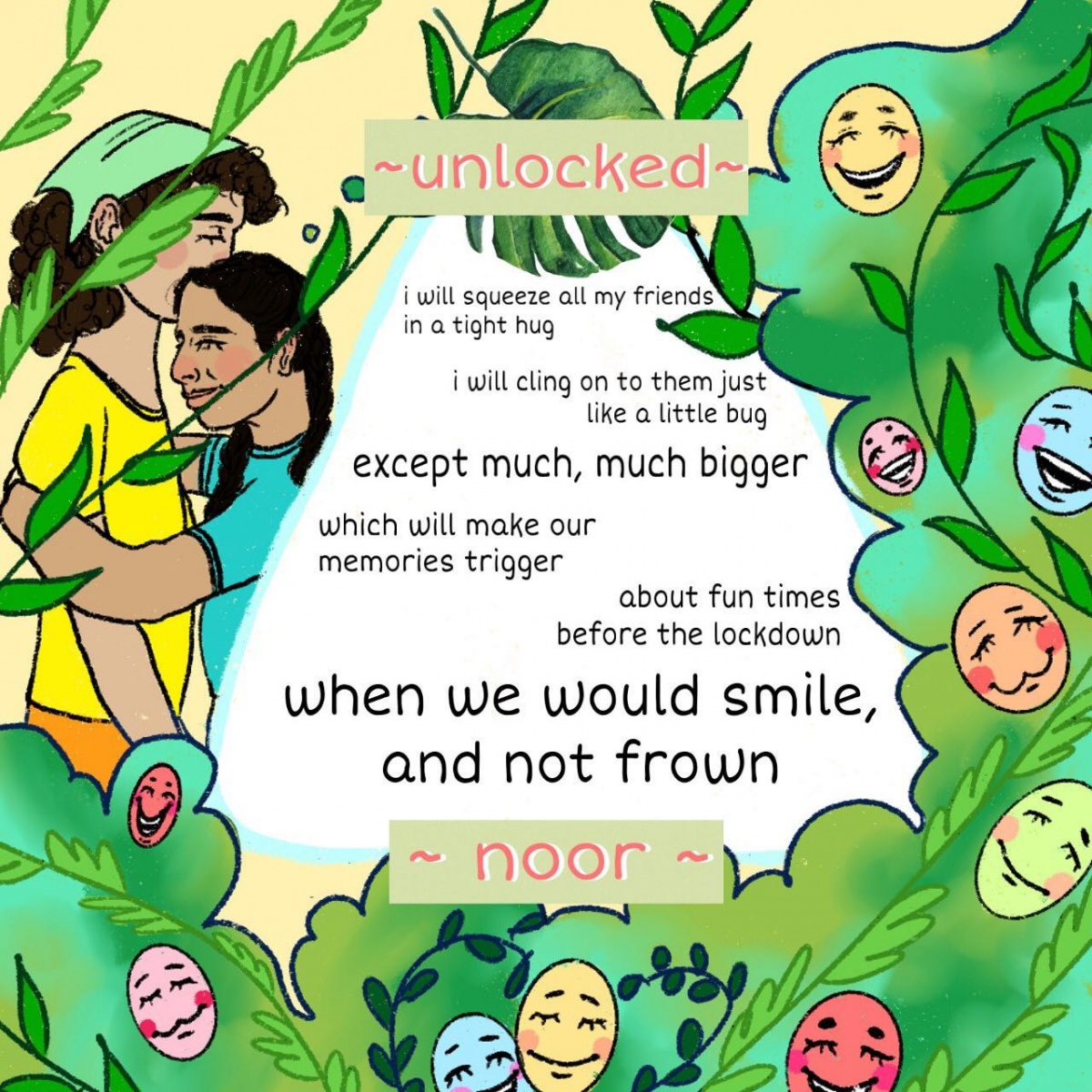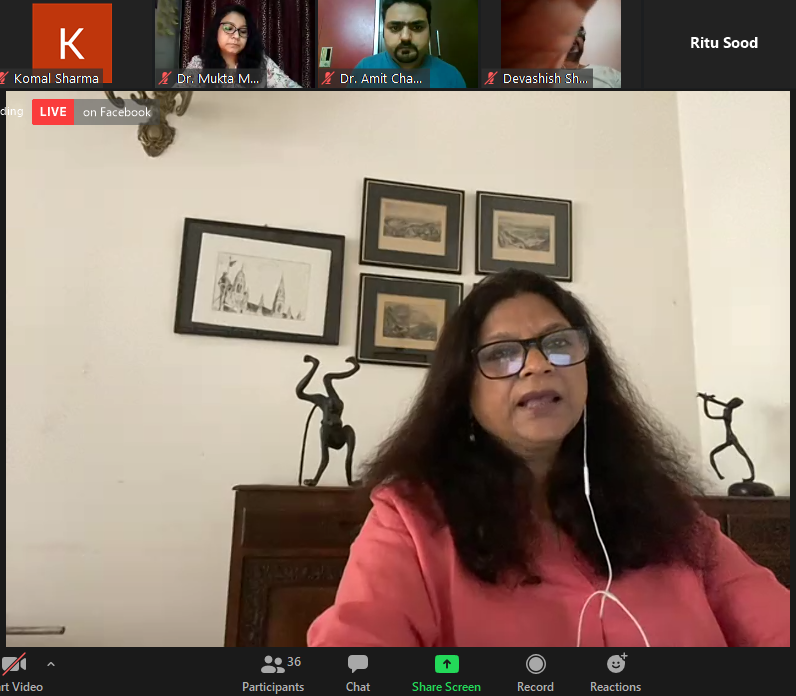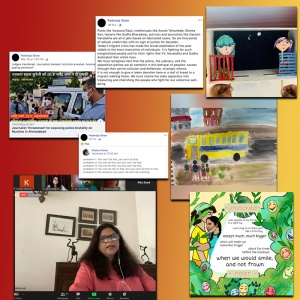Challenges on multiple fronts during COVID-19 pandemic : a view from India
It has been an eventful 60 plus days of lockdown in India – one of the world’s largest democracies.
COVID-19 cases have now reached almost 170000 despite a very strict lockdown.
by Nupur Basu
Besides the fear of what the pandemic can do if it spreads through its 1.3 billion population, there has sadly been a concerted dilution of rights for different segments of the Indian society. Two segments have been hit badly – the poorest of the poor ‘migrants’ (migrants are basically rural people who work in the cities largely in the informal sector) and the media.
Media intimidation:
Let me highlight regarding the media first. Right from the time the lockdown was announced by the Indian government to prevent the spread of Covid-19, there was an attempt to curb the rights of the media – print, television and digital.
The government of India actually appealed before India’s highest court to make it mandatory for the media to not publish anything related to the pandemic in the country, without getting it cleared from the government. In other words, it was a naked attempt to censor the media. The Supreme Court, luckily, did not grant this. But, the court came out with a rider for the media . It suggested that every story a journalist did on Covid, should also carry the official version.
I am sharing here the link to a piece I wrote on this subject recently. Media’s trial and tribulations in times of deadly coronavirus https://thefederal.com/analysis/medias-trial-and-tribulations-in-times-of-deadly-coronavirus/
In the early days reports of high handedness by the police against journalists who were on the field covering different aspects of the pandemic, began coming in thick and fast. There were reports from the nation’s capital, Delhi and in down south Hyderabad of journalists being assaulted by the police as they were on the field doing their coverage. A journalist from a Hindi news channel in Delhi was punched and hit despite showing the police his press card which proved he was part of the exempted essential services. This drew instant international condemnation from media watch organisations like the Committee to Protect Journalists (CPJ).
“Journalists are exempted from the ongoing lockdown in India because they provide vital news and information about the coronvirus outbreak,” said Aliya Iftikhar, CPJ’s senior Asia researcher, in New York. “Indian police must cease harassing and attacking them, and authorities must investigate attacks against journalists and ensure that those responsible are held to account.”
Soon there were First Information Reports (FIRs) being filed by the government and the police against journalists who were doing exposés on how politicians were breaking the lockdown laws, how food and other relief was not reaching the poor who had been hit the hardest in this pandemic.
An FIR was filed against Siddharth Vardarajan, Editor of the popular news website, The Wire, by the chief minister of India’s biggest state, Uttar Pradesh, for a tweet the editor had put out critiquing his administration.
Other cases against journalists kept filtering in from different quarters including from Gujarat (the home state of India’s Prime Minister Narendra Modi) where Dhaval Patel, editor of Face of Nation news website was charged with sedition and spreading false news amidst COVID-19. Patel had published a piece suggesting that the chief minister of Gujarat was going to be replaced for “mishandling” the pandemic. Gujarat was among the states in India reporting high corona virus positive cases and also high mortality rates.
Reports of legal cases against reporters covering the pandemic up and down the country also kept filtering in. The cases filed ranged from the outdated colonial sedition law to violation of provisions of Disaster Managment Act. Sedition cases against journalists could end up with them getting a life term in jail. Under the Disaster Management Act it could attract a two- year jail term. Cash fines were also going to be imposed. Journalists merely doing their job ended up with cases being foisted on them simply because what they were reporting was unpalatable to the government. There were cases from Kashmir, Uttar Pradesh, Karnataka, Mumbai, Tamil Nadu and even off the Indian mainland, from the Andaman and Nicobar islands.
In mid-April, columnist and human rights defender Gautam Navlakha was arrested by the National Investigating Agency (NIA) under a draconian law of the Unlawful Activities Prevention Act (UAPA) and various sections of the Indian Penal Code. At a time when CPJ had put out a worldwide call to governments to release journalists being held in prisons, 65 year-old Navlakha was bunged in Delhi’s high security prison, the Tihar Jail and then a month later, suddenly shunted by train to a prison in Maharashtra which had actually had COVID-19 cases and even a reported COVID-19 death.
“Sending Gautam Navlakha to jail at any time would be unjust and a clear effort to silence his critical writing. But for the Supreme Court and Indian authorities to insist on sending him to jail in the middle of a pandemic goes against their own directives and is a matter of life or death,” said Aliya Iftikhar, CPJ’s senior Asia researcher, in New York before his arrest. “Journalism should not amount to a death sentence. Indian authorities should allow Navlakha to remain free and stop pursuing charges against him.”
The CPJ appeal had fallen on deaf ears with authorities in India. Navlakha who wrote for the News click website had told CPJ that he believes he was being targeted for his work as a journalist and a human rights activist. His imprisonment evoked criticism from human rights organisations like Amnesty India, Human Rights Watch and People’s Union of Democratic Rights (PUDR). A letter from the chair of the European Parliaments sub-committee on Human Rights has written to India’s Home Minister expressing concern about Navlakha’s arrest and that of other human rights defenders saying that by its actions India had clearly violated the UN’s international human rights standards.
Media job losses:
Besides facing serious hurdles for merely doing their job, India’s journalists have also been facing huge job losses in the midst of this pandemic. In the last 60 days there has been a virtual bloodbath in the newspapers and television channels with large scale retrenchment of journalists, media workers and other employees.
First it was the refusal of newspaper vendors to distribute the papers as soon as the corona virus pandemic broke, which hit the industry badly. Then the advertisements shrunk – both government and private. The future looked bleak and managements decided that journalists were dispensable to tide over the financial crises. While some organisations decided on salary cuts, others simply asked the journalists not to come to work from the following day.
“[COVID-19] and the lockdown is being used as a pretext to sack journalists and other media employees – this is particularly true of the newspaper industry and is also happening in electronic media..it is very disgusting that they should have used this as an ‘opportunity’ to downsize specially when journalists cannot get together and protests on the streets –the pretext for the retrenchment is loss of advertisement and fall in circulation – although many media companies have substantial cash reserves and should not have ditched their employees at this time to downsize specially when so many reporters and camera crew are out in the field risking their lives to get the news out..” Sujata Madhok, General Secretary , Delhi Union of Journalists (DUJ) told IAWRT .
Even as I write this copy there is news that over 130 journalists and media professionals have been sacked in one of India’s most prominent English dailies – The Hindustan Times.
Testing positive:
Besides attempts at censorship, legal cases, arrests and job losses, journalists covering the pandemic have also been victims of the corona virus. One television channel alone is said to have over four dozen COVID-19 positive employees.
Migrant workers – a humanitarian crises in India.
I started the piece by saying that the pandemic had dealt a double blow to two segments – migrant workers and media. If the challenges have been difficult for the media , what the poor migrant workers have been through in the last 60 days has been absolutely catastrophic.
The sudden lockdown triggered a huge humanitarian crisis with millions of poor workers who had come to the Indian metros to earn a livelihood. Overnight they found they had no work in the cities and have no way to get home as trains and buses were off the roads. What ensued was a painful journey by the migrants – in the age group spanning between 1 year old to 70 year old, including pregnant women walking from anywhere between 300 to 1200 miles without food or water to reach home. Many died enroute (the estimated number of dead are over 600) collapsing with heart attacks, dehydration, run over by trains on rail tracks, killed on the roads by passing trucks and buses. The migrant crises is still unfolding before our eyes.
Our IAWRT India Chapter members have been actively involved in multiple ways in combating the crises in our country. Two veteran IAWRT members shared what the lockdown has symbolised for them.
By Padmaja Shaw : (former Board member)
India is facing a dual crisis on account COVID-19. The virus itself and the tragedy of millions of poor migrant labourers caught in different parts of the country without wages, food and shelter. An already marginalised section of the population is now driven to desperation and most of them are making frantic efforts to go back to the security of their home to be near their loved ones till the crisis is over. Every city in the country and villages are seeing thousands of people marching on the roads attempting to walk thousands of kilometres to their homes in the absence of any form of public transport.
IAWRT and the members of India chapter have been helping the migrants with food, shelter, transportation and leading fund-raising initiatives and also coordinating relief activities actively. Many members in Delhi , Bangalore, Mumbai, Hyderabad and Kolkata have been in the forefront of relief operations. Some of the members are attempting to document the experiences of the migrants through print, electronic media and filming. The crisis of the migrant population has overtaken the crisis of the virus by its magnitude.
What the near future holds in terms of community transmission is unknown. The IAWRT community in India will stand by to contribute to relief work in whatever way it can.

By Samina Mishra : (current Board member)
There had already been stuff written about living under lockdown from other places when the lockdown was first announced In India. But in all that I was reading, there was very little space for children’s voices – as is the case usually. Children are mostly on the margins when it comes to listening to them, it is expected that they will listen rather than be listened to. So I decided to start an art project for children that would give them a chance to express themselves while doing different kinds of art. Each day, I would post an exercise and the children would have 24 hours to do it and send in their work.
Anyone between the ages of 8 and 15 could participate but some enthusiastic parents helped even their 6 and 7 year olds to participate, and one grown-up also persisted in doing it 🙂 The exercises varied from writing poetry, taking photographs, recording a soundscape, shooting an interview with a grown-up and even making a puppet. The prompts were always around the lockdown, so the children got an opportunity to think about what their experience of it was like. We had some dedicated children who did all 21 days of the first phase of the lockdown, some were late entrants and some were erratic. But we have created a substantial archive of children’s art around the lockdown. These are of course children from a certain class context – access to the internet, English-speaking, urban.
So later in the lockdown I felt it was also important to try and reach children who had no access or limited access to the internet and so I began recording stories for children, for Archana’s community radio station, Radio Mewat.
The Lockdown Art Project submissions were shared everyday on Facebook and Instagram, at these links:
https://www.facebook.com/themagickeycentre/?ref=bookmarks
https://www.instagram.com/themagickeycentre/

By Archana Kapoor, IAWRT International Board Member
Radio Mewat broadcasts the stories and then also puts them up on Soundcloud so, I share them for others to use. I have also shared the recordings on WhatsApp with a couple of library projects in Gurgaon and Goa for children to access them on the phone.
I have been very careful about not going out since the corona virus outbreak in Delhi because I live with my parents who are both in the high-risk category. But as someone whose practice depends so much on interacting with people and being on location, it has been frustrating. Projects like these have helped me to feel connected in some way and not completely locked down.
https://www.facebook.com/radiomewat90.4/








